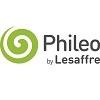
Content sponsored by:
Phileo by Lesaffre
Effect of Sc 47 yeast probiotic yeast on the performance and hindgut microbiota composition of weanling pigs
Published: August 14, 2019
By: G. KUHN & Tadele Kiros – Phileo by Lesaffre
The weaning transition in piglets is a stressful process associated with decreased feed intake, poor performance and increased susceptibility to infection, including post- weaning diarrhea. Antibiotic feed additives as ZnO or AGP have been commonly used during the weaning transition to prevent the postweaning lag in health and performance of piglets. However, the widespread use of subtherapeutic doses of antibiotics has contributed to the emergence of antibiotic resistant bacteria.
As an alternative, yeast probiotic supplementation has proven useful in reducing weaning stress and improving performance parameters of piglets. This study was performed to compared the performance and hindgut microbiota of weanling piglets subjected to different pre- and post-weaning.
Material and Methods
16 sows were selected and randomly assigned to two experimental groups (Yeast (L) vs Control (T)). 8 piglets from each sow, distributed equally according to sex and body weight were chosen and individually curled. The piglets of the 8 sows assigned to the yeast group (n=64) received orally a solution containing yeast every two days from day 1 until weaning, the piglets of the control group (n=64) had to them received an equal volume of sterile water. At 26.6 days of age, the 128 piglets were weaned and assigned to four treatment groups: Control - Control, Control - Yeast, Yeast - Control and Yeast - Yeast. From weaning, a fecal sample was taken once a week to determine fecal excretion of yeasts in the different groups. 4 weeks after weaning, two piglets per cell, 16 piglets per treatment group (n=64), were painlessly euthanized to collect and study the microbial ecology of the posterior intestine contents.
Main results
Average weight and ADG of piglets in the yeast-control and yeast-yeast groups were higher than those in the control-control group. Yeast supplementation resulted in development of microbial communities that were phylogenetically more homogeneous and less dispersed than those of the microbiota of control piglets. Correlation network analysis revealed that yeast supplementation was associated with enrichment of positive correlations among different bacterial genera of the small intestine ecosystem, suggesting a mechanism by which yeast supplementation could help regulate intestinal homeostasis and improve piglet performance (figure 1).

Discussion and Conclusion
The results observed confirm those of other studies previously conducted on the beneficial influence of the intake of probiotic yeasts on the growth performance of animals. Similarly, the results of experiment showed that live yeast intake during the preweaning period improved the performance of animals after weaning and that this effect is significantly maintained when supplementation is continued. It is interesting to note that several changes in the composition of the hind gut microbiota have been identified, associated with the improvement of performance parameters of piglets supplemented with yeast. Supplementation has tended to alter the structure of the hind gut microbiota to give it a more homogenous phylogenetic profile, enriched by a positive interaction between the potentially beneficial members of phyla actinobacteria and firmicutes.
Related topics:
Authors:
Phileo by Lesaffre
Phileo by Lesaffre
Recommend
Comment
Share

Would you like to discuss another topic? Create a new post to engage with experts in the community.


.jpg&w=3840&q=75)